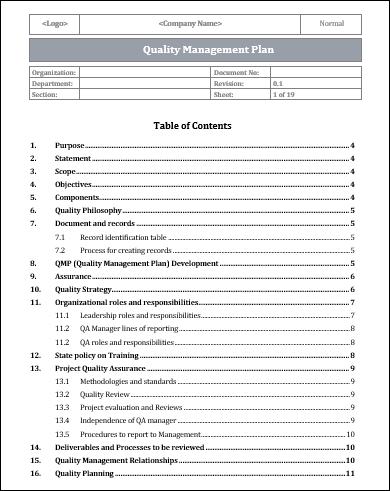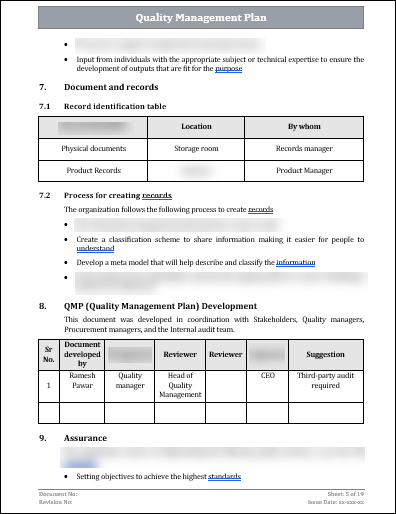ISO 9001 Quality Management Plan Template
An ISO 9001 Quality Management Plan is a crucial document that outlines the quality management processes and procedures to be followed in an organization. This plan serves as a guide for implementing and maintaining a quality management system that meets the requirements of the ISO 9001 international standard. By using this template, organizations can ensure that they have a comprehensive and systematic approach to managing quality in their operations. The plan includes essential sections such as quality objectives, quality policy, organizational structure, responsibilities, and resources needed for implementing the quality management system. This template is designed to help organizations develop and document their unique quality management plan, tailored to their specific requirements and processes.

Understanding The importance ISO 9001 Quality Management Plan Template
- Consistency: The ISO 9001 Quality Management Plan Template provides a consistent framework for managing quality across different projects and processes within an organization. It ensures that all quality-related activities are systematically planned, implemented, and controlled in a uniform manner.
- Compliance: ISO 9001 is an internationally recognized standard for quality management. By using the ISO 9001 Quality Management Plan Template, organizations can ensure that their quality management system meets all the requirements of the standard. This helps in achieving compliance with the ISO 9001 standard and enhancing the organization's credibility and reputation.
- Improved efficiency: The template outlines the key activities and processes that need to be followed for effective quality management. By using the template, organizations can streamline their quality-related activities and eliminate any unnecessary or redundant processes. This leads to improved efficiency and better resource utilization within the organization.
- Risk reduction: The ISO 9001 Quality Management Plan Template emphasizes the identification and mitigation of risks that could impact the quality of products or services. By following the template, organizations can proactively identify potential quality issues and take appropriate measures to prevent them. This helps in reducing the chances of quality-related problems and their associated costs.
- Customer satisfaction: The quality of products or services is a crucial factor in ensuring customer satisfaction. The ISO 9001 Quality Management Plan Template helps organizations in establishing processes for understanding customer requirements, monitoring customer feedback, and continuously improving their products or services. This results in higher customer satisfaction levels and increased customer loyalty.
- Continuous improvement: The ISO 9001 Quality Management Plan Template promotes a culture of continuous improvement within the organization. It encourages organizations to regularly review their quality management processes, identify areas for improvement, and take appropriate corrective actions. This leads to an ongoing cycle of improvement and ensures that the organization remains competitive in the market.
Key Elements of ISO 9001 Quality Management Plan Template
Creating a Quality Management Plan (QMP) based on ISO 9001 standards is essential for organizations aiming to establish and maintain a robust quality management system. Here are key elements that you may include in an ISO 9001 Quality Management Plan template:
- Document Control: Define procedures for document creation, review, approval, distribution, and version control.Specify how changes to documents are managed and communicated.
- Quality Policy: Outline the organization's commitment to quality and adherence to ISO 9001 standards.Communicate the quality policy to all relevant stakeholders.
- Risk Management: Identify potential risks to quality and establish a risk management process.Develop mitigation strategies for identified risks.
- Responsibility and Authority: Clearly define roles and responsibilities for individuals involved in the quality management system.Specify the authority levels for each role.
- Training and Competence: Detail the procedures for identifying training needs.Describe how competence is determined and maintained.
- Communication: Establish a system for internal and external communication related to quality.Specify methods and frequency of communication.
- Monitoring and Measurement: Define processes for monitoring and measuring key performance indicators (KPIs).Specify how data is collected, analyzed, and reported.
- Process Control: Identify key processes within the organization.Define controls and parameters for each process to ensure consistency and quality.
- Product and Service Realization: Outline the steps involved in the design, development, and delivery of products or services.Specify controls to ensure conformity during realization.
- Supplier Management: Outline procedures for selecting, evaluating, and managing suppliers.Ensure that suppliers conform to relevant quality standards.
- Nonconformity and Corrective Action: Define the process for identifying and addressing nonconformities.Establish procedures for corrective and preventive actions.
- Continuous Improvement: Encourage a culture of continuous improvement.Document processes for reviewing and improving the effectiveness of the quality management system.
- Record Keeping:Specify requirements for record creation, maintenance, and retention.Ensure that records are easily retrievable for audits.
- Internal Audit:Outline the process for conducting internal audits.Ensure that audits are systematic and thorough.
- Management Review:Schedule regular reviews with top management to assess the performance of the quality management system.Use reviews to make informed decisions for improvement.
- Legal and Regulatory Compliance: Identify applicable legal and regulatory requirements.Establish processes to monitor and ensure compliance.
- Emergency Preparedness and Response: Develop procedures for handling emergencies that may impact quality.Ensure that employees are trained on emergency response protocols.
- Documentation of the Quality Management System: Provide a comprehensive guide on how to document the quality management system.Specify formats, templates, and conventions for documentation.

The Benefits of an Effective Quality Management Plan
- Improved Customer Satisfaction: An effective quality management plan ensures that products or services meet or exceed customer expectations. This leads to increased customer satisfaction and loyalty, resulting in repeat business and positive word-of-mouth recommendations.
- Enhanced Productivity and Efficiency: By implementing quality control measures, businesses can reduce operational errors and waste. This improves productivity and efficiency, allowing organizations to allocate resources effectively and meet production goals more efficiently.
- Cost Reduction: A quality management plan helps identify and address areas of waste, defects, and inefficiencies, which can result in cost savings. By minimizing defects and waste, businesses can prevent unnecessary expenditure on rework or replacement of products and materials.
- Compliance with Regulations and Standards: An effective quality management plan ensures compliance with industry regulations and standards. This helps businesses avoid penalties, fines, and legal issues resulting from non-compliance, ensuring the organization stays on the right side of the law.
- Continuous Improvement: A quality management plan promotes a culture of continuous improvement within the organization. By constantly monitoring and evaluating processes, businesses can identify opportunities for improvement, implement corrective actions, and monitor the results1. Improved customer satisfaction: A quality management plan ensures that products or services meet or exceed customer expectations. T
- Increased efficiency and productivity: A well-designed quality management plan identifies potential areas of improvement in processes and workflows. By implementing efficient and effective quality control measures, organizations can streamline operations, reduce waste, and enhance productivity.
- Cost savings: Effective quality management helps to identify and rectify defects and errors early on, reducing the cost associated with rework, scrap, and customer complaints. It also minimizes the risk of costly product recalls, lawsuits, or regulatory penalties.
- Enhanced reputation and credibility: A robust quality management plan ensures a consistent level of quality in products or services. This builds trust and confidence in the organization among customers, stakeholders, and regulatory bodies, leading to a favorable reputation and increased credibility in the marketplace.
- Continuous improvement: A quality management plan includes provisions for ongoing monitoring, measurement, and analysis of processes and outcomes. This enables organizations to identify areas for improvement, implement corrective actions, and continuously enhance their products, services, and operations.
- Regulatory compliance: A quality management plan helps organizations meet the requirements of applicable industry standards, regulations, and certifications. By having proper quality control measures in place, organizations can ensure compliance and avoid legal or regulatory issues.
- Increased employee engagement and satisfaction: When a quality management plan is implemented effectively, it involves employees at all levels of the organization. This empowers employees, encourages accountability, and fosters a culture of continuous improvement. Engaged and satisfied employees contribute to better quality outcomes.
- Competitive advantage: Organizations with a strong quality management plan differentiate themselves from competitors by delivering consistent and high-quality products or services. This creates a competitive advantage in the market, attracting more customers and opportunities for business growth.
Conclusion
In conclusion, the ISO 9001 Quality Management Plan template is a valuable tool for organizations seeking to implement and adhere to the ISO 9001 standard. This template provides a structured framework for developing a comprehensive quality management plan that aligns with the requirements of ISO 9001.By utilizing this template, organizations can effectively document their quality objectives, processes, and procedures, as well as establish a system for monitoring and measuring performance.

